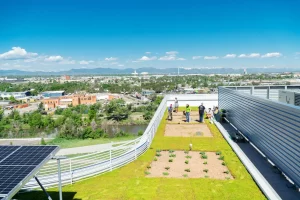Sky-High Synergy | Growing Food, Harvesting Energy, and Cultivating Hope | How Rooftop Agrivoltaics and Collaborative Innovations Are Shaping a Sustainable Tomorrow

Rooftop agrivoltaics—a system where solar panels and crops coexist—offers a dynamic new solution to some of society’s most pressing concerns: food, energy, and water. At Colorado State University, horticulturalist Jennifer Bousselot has successfully cultivated hundreds of pounds of produce under solar panels, showcasing the potential of this innovative approach. By emulating a forest canopy on top of a building, the solar panels shade delicate plants while generating clean energy, effectively merging two essential services into a single, underutilized space.
According to additional insights from Wired’s “The Ultra-Efficient Farm of the Future Is in the Sky,” agrivoltaics aligns with the growing demand for sustainable infrastructure in rapidly expanding urban areas. As cities struggle to meet the food requirements of swelling populations, installing solar arrays over rooftop gardens presents a highly efficient model. The synergy between plant growth and solar power helps regulate building temperatures, reduces greenhouse gas emissions, and conserves water—especially critical for regions prone to drought.
Bousselot’s project has yielded more than 600 pounds of frost-intolerant crops in a single season, despite Colorado’s unpredictable weather. Cool-season vegetables, like leafy greens, benefit from partial shade, which lowers plant stress and helps retain soil moisture. This resilience is essential for adapting to climate challenges. Moreover, because the energy produced by the solar panels supports the building’s electricity needs, agrivoltaics directly contributes to urban energy self-sufficiency.
Beyond the physical harvest, agrivoltaics represents a paradigm shift in how we view rooftops and vacant city spaces. Studies from reputable sources such as the U.S. Department of Energy’s National Renewable Energy Laboratory (NREL) have indicated that agrivoltaics can enhance overall land productivity. By combining agricultural production with solar installations, cities can address multiple objectives—lowering energy bills, providing fresh produce, and reducing carbon footprints—without expanding their physical footprint.
As highlighted in the original article on SpeciesUniverse.com, this approach demonstrates that even relatively small rooftop systems can make a meaningful impact on local food availability. It fosters community engagement and awareness, inviting urban dwellers to explore new ways of producing their own food. Over time, as more buildings adopt these practices, entire city blocks could become “vertical farms,” each contributing to a sustainable urban ecosystem.
The concept extends beyond mere environmental benefits. Implementing rooftop agrivoltaics can also create job opportunities, from construction and maintenance of solar panels to specialized horticulture and community-supported agriculture programs. The interdependence of technology and agriculture in these skyward farms reflects a larger movement toward integrated, holistic solutions that tackle modern challenges head-on.
Ultimately, the rooftop agrivoltaics project at Colorado State University stands as a testament to human ingenuity and our capacity to cultivate resilience. By blending solar energy production with sustainable food growth, we’re one step closer to a future where cityscapes double as productive, life-giving landscapes. As the research expands and more institutions replicate these findings, the vision of “The Ultra-Efficient Farm of the Future” is poised to become an everyday reality.
Key Takeaways:
- Integrative Solutions: Rooftop agrivoltaics merges food production, renewable energy, and resource conservation, all on the same limited urban footprint.
- Urban Resilience: Elevating agriculture to rooftops helps cities tackle land constraints, reduce carbon emissions, and enhance food security for a growing population.
- Multi-Benefit Approach: Rooftop agrivoltaics addresses food security, renewable energy, and water conservation all in one integrated system.
- Urban Adaptability: Harnessing the power of underused rooftops offers a practical way for cities to meet growing demands without expanding their footprint.
- Community Impact: From job creation to fresh produce, these skyward farms inspire a new wave of sustainable innovation and collective engagement.
“The idea behind rooftop agrivoltaics is to emulate a forest on top of a building. Just as the shade of towering trees protects the undergrowth from sun-stress, so too can solar panels encourage the growth of plants—the overall goal being to grow more food for ballooning urban populations, all while saving water, generating clean energy, and making buildings more energy efficient.”
Call to Action:
Ready to explore more on how we can reshape our skylines and empower our communities? Visit SpeciesUniverse.com for in-depth articles, inspiring videos, and ongoing discussions on building a brighter, greener future—one rooftop at a time.
More details: here

Leave a Reply